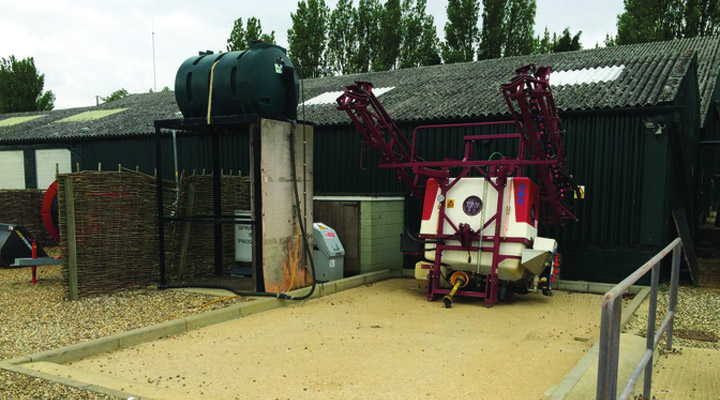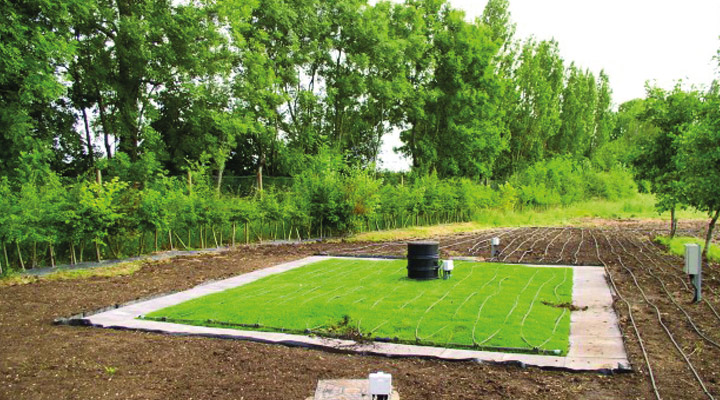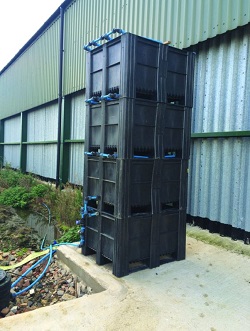Reducing Total Contaminated Water Volume
First Actions
Limiting pesticide use is a first consideration in minimising pollution. The case must be made for application and use must follow a rational and justifiable protocol. If pest or disease thresholds indicate no need to treat then not using a pesticide is a first step in contributing to lower pesticides in waters.
Pesticide Handling
Chemicals are stored in a dedicated store according to best practice. Guidance on chemical storage is given in the HSE leaflet AIS16. Sprayer operators are well trained, and they take all reasonable steps to avoid spillage or accidents. However, operators should routinely review their working practices to minimise splashes and spillages from container handling, emptying, and washing.
The condition of sprayers has improved through the adoption of the National Sprayer Testing Scheme (NSTS). However, small leaks and drips can occasionally occur. These are known as ‘hot spots’. Ensuring that the sprayer is kept well maintained will reduce these leaks and subsequent contamination from these ‘hot spots’ (the Voluntary Initiative supply a sprayer checklist). Early diagnosis of leaks and faults, through regular inspection of the sprayer followed by prompt remedial action will pay dividends.
Reducing Total Contaminated Water Volume
Most sprayer filling areas are located in a fairly open area close to a water supply. This can result in the area being liable to rainwater runoff or being close to drains which can act as pathways for contaminated waters. In addition, the filling area may be subject to other yard traffic which could spread contamination. This makes good practice essential to reduce and manage the potential pollution of spraying operations.
 Poor sprayer fill site/ Cracked sloping concrete, no control of liquids split.
Poor sprayer fill site/ Cracked sloping concrete, no control of liquids split. Good sprayer fill site. Good control by bunding and seperate drainage to a biobed.
Good sprayer fill site. Good control by bunding and seperate drainage to a biobed.
Where possible, sprayer filling areas should be bunded to limit yard water entry and be sited to prevent contamination from entering drains and watercourses. Ideally, this will be accompanied by roofing the pesticide preparation and handling areas. Roofing and bunding can be integrated to provide a fully dedicated area for sprayer and chemical storage, as well as protected sprayer filling and wash-down area. A sprayer fill area may easily be 7 x 5m and a year’s rainfall may thus result in 21m3 of water falling on this area so the benefits from roofing or covering are clear.
Sprayer equipment wash-down will also produce contaminated waters. The amount may be linked to pressure washer outputs and frequency of the work. Currently this wash-down procedure is recommended in a part of the field previously sprayed at a lower rate, but bioremediation developments and exemptions under the Agricultural Waste Regulations do permit equipment wash-down at a bunded fill site where the output is directed to a bioremediation facility such as a biobed, biofilter or Phytobac.
Containment of Contaminated Waters
 Roofed fill area, controlling rainwater inputs, well bunded containment of inadvertent spills and drips
Roofed fill area, controlling rainwater inputs, well bunded containment of inadvertent spills and dripsContainment is an essential part of the management of contaminated waters. The simplest form of this is a raised bund around the fill area. A concrete hump approximately 100mm high, 300mm wide provides a useful barrier to yard flash floods in most situations.This bund is an acceptable compromise between water protection and vehicle access.
Some areas may allow a sunken fill area to be constructed which can provide the same effect as a manufactured bund, particularly where a roof is adopted. Such layouts can also provide significant holding capacity which can accommodate the emergency containment that matches the capacity of the sprayer tank.
A slope of 1:100 should be incorporated into the fill area and the water directed via a silt trap to an optional buffer or storage tank. To comply with government regulations (RP27 – Sprayer or applicator load and washdown area) a buffer tank can have a maximum capacity of 1,500 litres. Combined with a bunded fill area a significant holding capacity can be formed which can accommodate the emergency containment that matches the capacity of the sprayer tank.
To estimate the volume of contaminated water that is produced from washing down your sprayer equipment consider the pressure washer flowrate and the time spent washing down along with frequency.
Dealing with contaminated waters
Permitted Disposal Area
Under landfill regulations the direct disposal of “washings” to soil or grassed areas is illegal. Disposal can only be to areas identified in an Environmental Permit issued by the Environment Agency. This replaces the old ‘Groundwater Authorisation’. Under an Environmental Permit, an area of land will be assessed and designated as suitable for receiving pesticide washings. There may be limits to the quantities and types of spray wastes that are allowed. There will also be an annual fee to maintain the permit.
Waste Collection
Liquids contained from the fill area may be collected by a licensed waste carrier. Such action will be subject to a fee and relevant waste transfer notice. Minimisation of liquid volume produced help manage costs.
Carbon Filtration
For many years it has been possible to install a carbon filtration system (such as the Sentinel) to receive waste spray liquids and reduce their potential to pollute. This system can treat up to 8,000 litres over any 24 hours. It can be operated under a T29 exemption which must be registered with the Environment Agency. The treated output can be disposed to land but this will require an Environmental Permit from the Environment Agency. In addition, the carbon filter and separated ‘sludge’ will need to be removed by a licensed waste carrier and will require a waste transfer note and will involve a fee.
Bioremediation
Currently (2015) there are three approaches offering remediation which are included in the Environment Agency T32 Exemption from the Agricultural Waste Regulations: biobed, biofilter and Phytobac.
All three include the use of natural materials to reduce the polluting potential of waste spray liquids. All have been developed from early work in Sweden where a mixture of straw, soil and compost was shown to lower the pesticide content in waters by between 10,000 and 100,000 times.
You can store or treat up to 15,000 litres of dilute pesticide washings in a 12-month period.
Biobed
 A well-constructed lined biobed
A well-constructed lined biobedThis will deal with large volumes of spray waste, up to 15,000 litres per annum plus any rainfall falling on the spray fill area and biobed. Essentially it is a lined, below ground pit, containing a mixture (biomix) by volume of 50% straw, 25% friable soil, 25% compost. Liquids entering the biobed from the fill area and from rainfall pass into the biobed and through the biomix. They are then pumped from a sump within the liner to a neighbouring vegetated area as minor irrigation.
The bioremediation takes place within the biomix. Extensive field trials and use have shown reliable reductions in pesticide levels in the water discharged.
 Stacked biofilter from a covered sprayer fill area
Stacked biofilter from a covered sprayer fill areaBiofilter
Where smaller volumes have to be dealt with a biofilter may be appropriate. This typically consists of 3 x 1,000 litre capacity Intermediate Bulk Containers (IBCs) stacked one above the other with a connection made between the two. Each IBC contains the biomix as used in a biobed. Liquid directed from the filling area is pumped to the highest unit and then drains through the biomix to pass to the next unit below and thus to the lowest unit. This vertical stack has also been shown capable of similar degradation as a biobed and the liquid passing from the lowest IBC is drained or pumped to a vegetative area as minor irrigation.
Phytobac
This development has been supported by Bayer CropScience. It is essentially similar to a biobed, but is designed as a closed system to ensure that no liquid is discharged from the unit at the end of bioremediation. This is achieved by enhancing evaporation from the unit.
The Phytobac contains a biomix (70% top soil and 30% straw by volume) normally within a concrete chamber, either above or below ground, which has a roof to prevent rainfall entry and enhance evaporation. The roof is mounted to promote good ventilation through the air space above the biomix.
All liquids collected from the bunded fill area are directed via gravity or a pumped system to the Phytobac.
The bioremediation takes place within the biomix. Extensive field trials and use have shown reliable reductions in pesticide levels.

Bayer CropScience
An introduction to Phytobac & Biobed systems